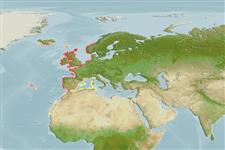Teleostei (teleosts) >
Blenniiformes (Blennies) >
Blenniidae (Combtooth blennies) > Salariinae
Etymology: Lipophrys: Greek, lipos = fat + Greek, ophrys = eyebrow (Ref. 45335).
More on author: Linnaeus.
Environment: milieu / climate zone / depth range / distribution range
Ecology
Marine; demersal; non-migratory; depth range 0 - 8 m (Ref. 5981). Temperate; 65°N - 18°N, 32°W - 11°E
Eastern Atlantic: southern Norway to Morocco and Madeira, including the Mediterranean and the Balearics.
Length at first maturity / Size / Weight / Age
Maturity: Lm 8.0 range ? - ? cm
Max length : 17.0 cm TL male/unsexed; (Ref. 747); max. reported age: 10 years (Ref. 35388)
Facultative air-breathing (Ref. 126274); A resident intertidal species with homing behavior (Ref. 32612) found in shallow waters of rocky coasts. May remain out of water under rocks or seaweeds (Ref. 31184). Mostly active at daytime during high tide. Breathes air when out of water (Ref. 31184). Feeds on small benthic invertebrates, especially gastropods, barnacles and amphipods, and algae (Ref. 31184). Also, diet of crabs, polychaetes, isopods, copepods, limpets, mussels and small molluscs (Ref. 94105). Oviparous (Ref. 205). Eggs measuring 1.5 mm (Ref. 35388) are demersal and adhesive (Ref. 205). Spawning takes place in April - August (Ref. 35388).
Oviparous, distinct pairing (Ref. 205). Male guards eggs from several females (Ref. 5981).
Zander, C.D., 1986. Blenniidae. p. 1096-1112. In P.J.P. Whitehead, M.-L. Bauchot, J.-C. Hureau, J. Nielsen and E. Tortonese (eds.) Fishes of the North-eastern Atlantic and the Mediterranean, volume 3. UNESCO, Paris. (Ref. 5981)
IUCN Red List Status (Ref. 130435)
Threat to humans
Harmless
Human uses
Fisheries: of no interest; aquarium: public aquariums
More information
ReferencesAquacultureAquaculture profileStrainsGeneticsElectrophoresesHeritabilityDiseasesProcessingNutrientsMass conversion
Tools
Special reports
Download XML
Internet sources
Estimates based on models
Preferred temperature (Ref.
123201): 9.8 - 19.3, mean 12.3 °C (based on 364 cells).
Phylogenetic diversity index (Ref.
82804): PD
50 = 0.7500 [Uniqueness, from 0.5 = low to 2.0 = high].
Bayesian length-weight: a=0.01072 (0.00480 - 0.02393), b=3.01 (2.82 - 3.20), in cm total length, based on LWR estimates for this (Sub)family-body shape (Ref.
93245).
Trophic level (Ref.
69278): 3.5 ±0.33 se; based on food items.
Generation time: 3.7 ( na - na) years. Estimated as median ln(3)/K based on 1
growth studies.
Resilience (Ref.
120179): Medium, minimum population doubling time 1.4 - 4.4 years (tmax=10; k=0.3).
Fishing Vulnerability (Ref.
59153): Low to moderate vulnerability (33 of 100).
Nutrients (Ref.
124155): Calcium = 71.7 [39.0, 163.8] mg/100g; Iron = 0.421 [0.255, 0.762] mg/100g; Protein = 18.5 [17.6, 19.5] %; Omega3 = 0.548 [0.285, 1.041] g/100g; Selenium = 5.86 [2.73, 13.11] μg/100g; VitaminA = 28.3 [7.5, 104.2] μg/100g; Zinc = 0.802 [0.545, 1.171] mg/100g (wet weight);
